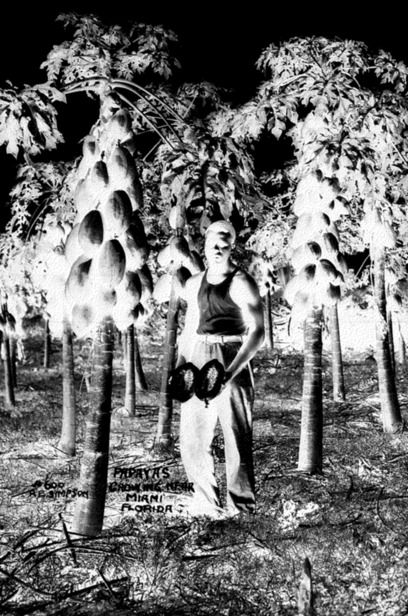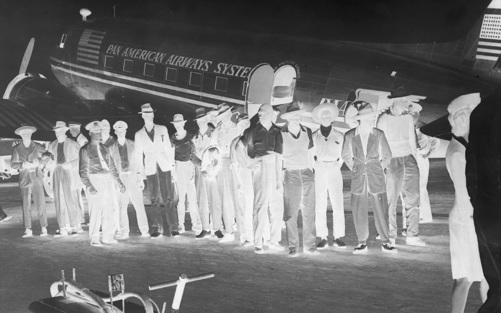Read The History of Florida Online
Authors: Michael Gannon
Tags: #History, #United States, #State & Local, #Americas
The History of Florida (100 page)
gerated tales of economic success in the “promised land”—a familiar theme
in immigrant literature. The introduction of regular steamship service be-
tween Miami and Nassau by the early twentieth century made the trip to
proof
Florida cheap and convenient. According to Bahamian population studies,
ten to twelve thousand Bahamians left the islands for Florida between 1900
and 1920—about one-fifth of the entire population of the Bahamas.
In early-twentieth-century Florida, Bahamian newcomers found work as
railroad laborers, as construction workers and stevedores in early Miami,
and in clearing land for agriculture and residential development. The emer-
gence of Miami as a tourist center provided job opportunities for Bahamian
women as maids, cooks, and laundry and service workers in the city’s tour-
ist hotels and restaurants. Large numbers of Bahamians also worked in the
citrus industry and as field hands in south Florida agriculture. Many Ba-
hamians came as migrant laborers during the harvest season, returning to
the islands each summer. In the years before effective federal regulation of
immigration, Bahamian blacks moved easily and often between the islands
and south Florida.
The Bahamian presence in Miami and south Florida was proportion-
ately large. By 1920, when Miami’s population stood at 29,571, the foreign-
born made up one-quarter of that total. More than 65 percent of Miami’s
immigrants—some 4,815 individuals—were blacks from the West Indies,
mostly Bahamians. They comprised 52 percent of al Miami’s blacks and 16.3

478 · Raymond A. Mohl and George E. Pozzetta
proof
Agricultural, construction, and service workers from the Bahamas provided an impor-
tant labor force over several decades during Miami’s early history. This scene from a
papaya plantation in the early twentieth century typified the Bahamian labor migra-
tion to Florida. R. E. Simpson postcard photograph from the personal collection of
Raymond A. Mohl.
percent of the city’s entire population. In 1920, Miami had a larger popula-
tion of black immigrants than any other city in the United States except
New York. As agriculture expanded along south Florida’s Atlantic coastal
region, Bahamians responded to new work opportunities. Consequently,
the 1945 Florida state census reported more foreign-born blacks living in
Palm Beach County (5,597) than in Dade County (4,609).
For thousands of Bahamians from the 1890s to the 1940s, the widespread
perception of economic opportunity in Florida was too strong to resist.
Immigration and Ethnicity in Florida History · 479
Work was plentiful, but Bahamians routinely encountered racial segrega-
tion and discrimination in Florida. Racial confrontations involving Baha-
mian blacks and white policemen in Key West, Miami, and Jacksonvil e
were not uncommon. Unaccustomed to harassment and racial barriers, Mi-
ami, Key West, and West Palm Beach Bahamians in large numbers joined
the Universal Negro Improvement Association, the black nationalist move-
ment led by Marcus Garvey.
As was true of Latins in Tampa, Bahamians built flourishing ethnic
communities in Florida, especial y in Key West and in Coconut Grove and
Overtown, two black neighborhoods in early-twentieth-century Miami
where they established businesses and laid the foundations for churches
and a vibrant organizational life. The permanence and stability of these
neighborhoods, along with strong links to the islands, contributed to cul-
tural maintenance and an enduring ethnic identity. Unfettered Bahamian
migration ended with World War II, when the agricultural labor supply in
Florida came under governmental regulation. But enough Bahamians had
already settled permanently in south Florida to sustain the growth of cohe-
sive communities held together by a strong sense of identity and cultural
distinctiveness.
Bahamian migration to Florida was paral eled by the early Cuban mi-
proof
gration to Key West and Tampa. Florida’s human connection to the Ca-
ribbean intensified as the twentieth century progressed. In retrospect, it is
somewhat prophetic that the achievement of Cuban independence (1898)
and the founding of Miami (1896) coincided at the end of the nineteenth
century. The era of the Spanish-American War represented the first phase
of that magnetic pull that has linked Miami and Havana as the twin cities
of the Caribbean for much of the twentieth century. Key West, Tampa, and
New York continued to be centers of Cuban exile life in the United States
through the 1920s, but Miami was already beginning to emerge as a conve-
nient place of political exile for Latin American revolutionaries, dissidents,
and dictators. By the late 1920s, as many as 1,000 Cuban exiles, mostly young
and radical university students opposed to the dictatorial regime of Gerardo
Machado, had set up an exile headquarters in Miami. With the success of
the 1933 Cuban Revolution, anti-Machado exiles in Florida returned home,
with the blessing of the
Miami
Herald
, which editorialized prophetical y
in 1933 that “Miami’s gates will always be open to Cubans, should the time
ever come again when they need a refuge.”6 Actual y, that time came rather
quickly, since ousted Machado supporters immediately took up new places
in Miami exile.

480 · Raymond A. Mohl and George E. Pozzetta
Bahamian labor migrants continued to work in Florida agriculture well into the twen-
tieth century. These farmworkers arriving in Miami by plane in April 1943 were part of
a special temporary labor program during World War II. Courtesy of the State Archives
of Florida,
Florida Memory
, http://floridamemory.com/items/show/29468.
It had become a natural pattern. As Harry Guggenheim, U.S. ambassa-
proof
dor to Cuba in the early 1930s, noted at the time, Cuban exile leaders went
to New York and Washington to solicit financial and political support, but
the chief point of exile had already become Miami, where, Guggenheim
said, “the rank and file of emigres and followers of the junta concentrate,
since they can live more easily in Florida’s sunshine.”7 Older communities of
earlier Cuban immigrants were still thriving in Tampa and Key West, num-
bering about 7,400 and 1,600 respectively in 1930. But a new Cuban exile
community began to emerge in Miami during the 1930s; by 1940, Miami
had more than 1,100 Cuban-born residents, a colony that gradual y grew
even larger during the next two decades. Cuban-born workers, especial y
women, made up a large portion of the garment workers in Miami’s needle
trades in the early 1950s. Even before the success of Castro’s revolution in
1959, a concentrated area of Cuban settlement had begun to take shape in
Miami’s central city, and the neighborhood was already being called “Little
Havana.” So the exiles who flowed out of Cuba in such astonishing numbers
during the 1960s and after were only the latest in a long line of Cubans who
historical y sought refuge in Florida.
Despite the concentration of Latins in Tampa and of Bahamians and Cu-
bans in Key West and Miami in the early twentieth century, Florida had
Immigration and Ethnicity in Florida History · 481
not yet become a major destination for immigrants to the United States. In
1930, for instance, the foreign-born made up about 12 percent of national
population; by contrast, Florida had just under 70,000 white and black im-
migrants at the time, or about 4.7 percent of the state’s total population.
According to the 1930 U.S. census, more than half of those immigrants lived
in the Tampa, Miami, and Jacksonville metropolitan districts. In addition to
English, the most popular “mother tongues” of Florida’s urban immigrants
in 1930 were Spanish and Italian in Tampa; German, Yiddish, and Arabic
in Jacksonville; and German, Yiddish, and Spanish in Miami. Despite small
numbers of foreign-born, urban Florida was already displaying some ethnic
and cultural diversity by the 1930s.
Over the next thirty years, immigration statistics for Florida converged
with national patterns. By 1960, for example, the proportion of immigrants
in Florida’s population had increased marginal y to 5.5 percent. For the na-
tion as a whole, the immigrant proportion had declined to 5.4 percent of
total population, reflecting the demographic consequences of the federal
immigration restriction legislation of the 1920s. The foreign-born propor-
tion for most of Florida’s cities and counties hovered at or below the state
average. But some dramatic exceptions appeared, such as in Miami Beach,
where 33 percent of the city’s population was foreign-born in 1960—mostly
proof
East European Jewish immigrants who had retired to Florida from north-
eastern states. Demographical y speaking, Miami-Dade County appeared
as an oddity in the 1960 U.S. census, with 113,000 foreign-born—over 40
percent of the state’s total—whose mother tongues included German, Pol-
ish, Hungarian, Russian, and Yiddish, as well as English and Spanish. Pock-
ets of immigrants clustered in other parts of Florida, too. Tarpon Springs,
with many Greek immigrants, was almost one-quarter foreign-born. The
foreign-born made up 14 percent of the population of Lake Worth, a small
city in Palm Beach County where Finnish immigrants began settling in the
1930s. Jacksonvil e had a miniscule foreign-born population in 1960, but
the city had long been home to several thousand Syrian-Lebanese people, a
multigenerational ethnic community that grew to over 25,000 by the 1990s.
Surprisingly, Canadian immigrants, largely a post–World War II phenom-
enon, comprised the largest foreign-born group in the Orlando, Jackson-
ville, Tampa–St. Petersburg, and Fort Lauderdale–Hol ywood metropolitan
areas. Final y, Miami-Dade County already had more than 50,000 Hispanics
in 1960, reflecting both a growing Puerto Rican community and the early
surge of Cubans just before and just after the fall of Batista in 1959.
The success of Fidel Castro’s Cuban Revolution in 1959 permanently
482 · Raymond A. Mohl and George E. Pozzetta
altered the trajectory of Florida’s demography. The migration of Cuban ex-
iles to the United States forms one of the most compelling and fascinating
chapters in the history of American immigration. Over the course of a half
century, more than 1.1 million Cuban exiles arrived in the United States, a
large majority of whom settled in Florida, especial y the Miami area. They
came to the United States in several waves over five decades, an erratic mi-
gration flow dictated by the state of U.S.-Cuban relations at any particu-
lar time. This relationship also dictated the form of the exile movement.
At various times, the Cubans arrived in Florida by airlift, boatlift, travel
through third countries, or as escapees on small boats and rafts. American
policymakers, beginning with the Eisenhower administration, encouraged
the exile migration to destabilize and discredit Castro’s communist regime.
To a large degree, however, Castro control ed the timing and methods of
exile migration, periodical y opening and closing the doors, thus permitting
the exodus of dissidents to defuse political opposition or internal economic
